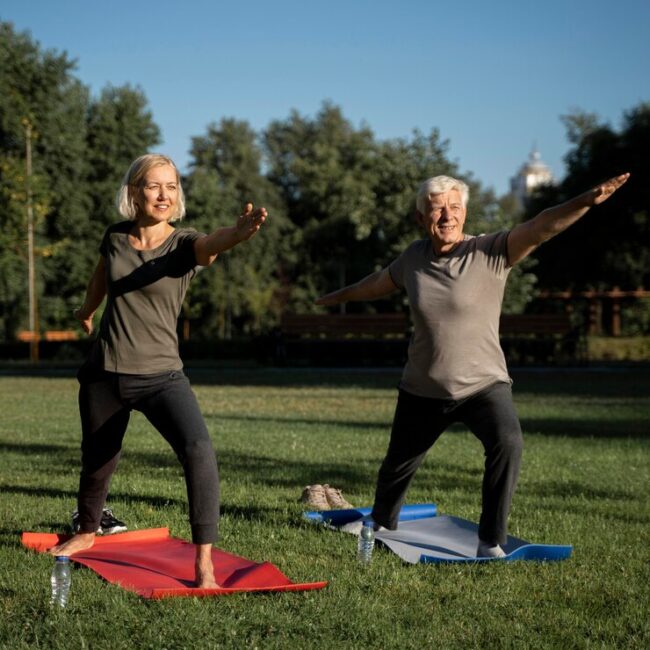
When you reach your forties, it’s crucial to prioritize your health and fitness in order to maintain a strong and healthy body. Regular exercise becomes even more important as our bodies naturally start to lose muscle mass and bone density. However, with the right exercise routine, it’s possible to not only slow down these effects but also improve overall health and well-being.
There are several types of exercises that are particularly beneficial for individuals over 40. Strength training is one of them, as it helps to increase muscle mass, improve bone density, and boost metabolism. Engaging in strength training exercises can be as simple as using dumbbells or resistance bands, or even performing bodyweight exercises.
In addition to strength training, cardiovascular exercises are also crucial for maintaining heart health and improving stamina. Activities such as jogging, swimming, or cycling can be great options. It’s important to find an exercise that you enjoy, as this will increase the likelihood of sticking to a routine.
Flexibility exercises are equally important, as they help to improve posture, prevent injuries, and enhance overall mobility. Incorporating activities such as yoga, Pilates, or stretching into your fitness routine can help to maintain flexibility and reduce the risk of stiffness and joint pain.
Age-related changes in the body
As we age, our bodies go through a number of changes that can impact our overall health and fitness. These age-related changes can be both physical and physiological, and it is important to understand them in order to develop an effective exercise routine and maintain a healthy lifestyle.
One of the most noticeable age-related changes is a decrease in muscle mass and strength. This is known as sarcopenia and can begin as early as our thirties. As we age, our bodies also tend to store more fat, especially around the abdomen. This can lead to an increase in weight and a decrease in overall fitness levels.
Another age-related change is a decrease in bone density, known as osteoporosis. This can increase the risk of fractures and make it more difficult to perform weight-bearing exercises. Maintaining a regular exercise routine that includes weight-bearing exercises can help to slow down the loss of bone density and improve overall bone health.
As we age, our joints also become less flexible and may experience a decrease in range of motion. This can make it more difficult to perform certain exercises and activities. Stretching exercises, such as yoga or Pilates, can help to improve flexibility and maintain joint health.
Lastly, our cardiovascular system also undergoes changes as we age. Our heart rate tends to decrease and our blood vessels may become less elastic. Regular aerobic exercise, such as walking or swimming, can help to maintain cardiovascular health and improve overall fitness.
In conclusion, understanding the age-related changes that occur in our bodies is essential in order to develop a fitness routine that is tailored to our specific needs. By incorporating a variety of exercises that target different systems of the body, we can maintain our health and fitness well into our forties and beyond.
Age-related changes in organ functions

As we age, our bodies undergo various changes, including changes in the functions of our organs. These age-related changes can have a significant impact on our overall health and well-being.
One of the major organs that experiences age-related changes is the heart. Over time, the heart may become less efficient at pumping blood, leading to reduced cardiovascular fitness. This can increase the risk of conditions such as high blood pressure and heart disease. It is important to engage in regular aerobic exercises to keep the heart healthy and maintain cardiovascular fitness.
The lungs also undergo age-related changes, with lung capacity tending to decrease over time. This can lead to shortness of breath and decreased oxygen intake during physical activity. However, regular exercise can help improve lung function and increase lung capacity, supporting overall respiratory health.
The kidneys play a crucial role in filtering waste products from the blood and maintaining proper fluid balance in the body. With age, the kidneys may experience a decline in function, which can affect their ability to perform these vital tasks. Staying hydrated and consuming a balanced diet can support kidney health and help minimize the impact of age-related changes.
Age can also affect the digestive system, with a reduction in the production of digestive enzymes and a decrease in gastrointestinal motility. These changes can lead to issues such as indigestion, constipation, and nutrient malabsorption. Eating a diet rich in fiber, staying hydrated, and exercising regularly can help promote healthy digestion and prevent digestive issues.
Furthermore, age-related changes can impact the musculoskeletal system, leading to the loss of muscle mass and strength, as well as a decrease in bone density. This can increase the risk of falls, fractures, and musculoskeletal disorders. Engaging in regular strength training exercises and consuming a diet rich in calcium and vitamin D can help maintain muscular and skeletal health.
In conclusion, age-related changes in organ functions are a natural part of the aging process. However, through a combination of regular exercise, a balanced diet, and healthy lifestyle choices, we can help mitigate the impact of these changes and maintain overall organ health.
Finding effective ways to maintain health

Maintaining good health becomes increasingly important as we age, especially after 40. Fortunately, there are many effective ways to promote and sustain overall health during this stage of life.
1. Regular exercise: Engaging in physical activity is crucial for maintaining health after 40. Aim to incorporate a combination of aerobic exercises, strength training, and flexibility exercises into your routine. Consult a professional to design an exercise plan suitable for your age and fitness level.
2. Balanced diet: Eating a nutritious and balanced diet is essential to promote health at any age. Pay attention to your caloric intake and ensure you consume a variety of fruits, vegetables, lean proteins, whole grains, and healthy fats. Additionally, stay hydrated by drinking plenty of water throughout the day.
3. Adequate sleep: Getting enough quality sleep is vital for overall health and well-being. Aim for 7-8 hours of sleep each night to allow your body to rest and rejuvenate. Create a relaxing sleep environment by keeping your bedroom dark, quiet, and at a comfortable temperature.
4. Stress management: Chronic stress can have detrimental effects on your health, so finding effective ways to manage stress is important. Consider practicing relaxation techniques such as deep breathing, meditation, or yoga. Engaging in hobbies or activities you enjoy can also help reduce stress levels.
5. Regular medical check-ups: Scheduling regular check-ups with your healthcare provider is crucial for detecting and preventing any potential health issues. Take advantage of screenings, vaccinations, and tests recommended for your age group.
6. Limiting alcohol and tobacco consumption: Excessive alcohol consumption and smoking can significantly impact your health, especially as you age. Aim to limit alcohol consumption and seek help if you struggle with quitting smoking.
7. Social interaction: Maintaining a strong network of social connections is vital for mental and emotional health. Keep in touch with friends and family, join social clubs or groups, and engage in community activities to foster a sense of belonging and support.
By adopting these effective ways to maintain health, you can improve your overall well-being and enjoy a fulfilling life after 40.
Exercises for health and maintaining shape
Regular exercise is crucial for maintaining good health and fitness, especially as we age. Engaging in physical activity can help prevent chronic diseases, improve cardiovascular health, manage weight, boost energy levels, and enhance mental well-being.
Here are some exercises that are particularly beneficial for individuals over 40:
| Exercise | Description |
|---|---|
| Strength training | Lifting weights or using resistance bands can help maintain muscle mass, increase bone density, and prevent age-related muscle loss. |
| Cardiovascular exercises | Activities such as brisk walking, jogging, cycling, swimming, or dancing can improve heart health, burn calories, and enhance endurance. |
| Yoga and Pilates | These low-impact exercises can improve flexibility, balance, and posture, and help reduce stress and muscle tension. |
| Stretching | Performing regular stretches can improve joint mobility, prevent injuries, and alleviate muscle tightness. |
| Functional exercises | Exercises that mimic everyday movements, such as squats, lunges, and planks, can improve balance, stability, and overall functional fitness. |
It’s important to consult with a healthcare professional or a certified fitness trainer before starting any new exercise program, especially if you have any pre-existing health conditions or concerns. They can provide personalized recommendations and guidance based on your specific needs and goals.
Remember, consistency is key when it comes to exercise. Aim for at least 150 minutes of moderate-intensity aerobic activity or 75 minutes of vigorous-intensity aerobic activity every week, in addition to strength training exercises at least twice a week.
By incorporating these exercises into your routine, you can improve your overall health, maintain your shape, and enjoy the numerous benefits that come with staying active and fit.
Cardiovascular training and endurance
Cardiovascular training is an essential component of any fitness routine, especially for adults over the age of 40. Engaging in regular cardiovascular exercises not only improves heart health but also helps to maintain overall fitness and endurance. Here are some effective cardio exercises that can help you stay fit and healthy:
- Running or jogging: Running or jogging is a great way to improve cardiovascular endurance. Start with a brisk walk and gradually increase your pace to a jog or run. Aim for at least 30 minutes of running or jogging at least three times a week.
- Cycling: Cycling is a low-impact exercise that puts minimal stress on the joints. Whether you prefer outdoor cycling or using a stationary bike, cycling helps to improve cardiovascular fitness and leg strength. Try to cycle for at least 45 minutes to an hour, three times a week.
- Swimming: Swimming is a full-body workout that is gentle on the joints. It helps to improve cardiovascular endurance, strength, and flexibility. Aim for at least 30 minutes of swimming at least three times a week.
- Jumping rope: Jumping rope is a fun and effective cardiovascular exercise that can be done at home or outdoors. It helps to improve coordination, balance, and cardiovascular endurance. Start with short intervals and gradually increase the duration.
- Aerobic classes: Joining aerobic classes, such as Zumba, kickboxing, or dance classes, can be a great way to get your heart rate up and improve cardiovascular fitness. These classes also provide a social aspect, which can make exercising more enjoyable.
Remember to warm up before starting any cardio exercise and cool down afterward to prevent injuries. Listen to your body and gradually increase the intensity and duration of your workouts as your fitness level improves.
By incorporating cardiovascular training into your fitness routine, you can improve your heart health, boost your endurance, and maintain overall fitness well into your 40s and beyond.
Strength training and maintaining muscle mass
As we age, our muscles naturally become weaker and lose mass. However, by incorporating regular strength training exercises into our fitness routine, we can slow down the decline in muscle mass and maintain our strength.
Strength training, also known as resistance training or weightlifting, involves using free weights, machines, or your own body weight to build strength and increase muscle mass. This type of exercise helps to preserve muscle tissue, reduce the risk of injury, and improve overall physical function.
When it comes to strength training after 40, it’s important to focus on both compound exercises and isolation exercises. Compound exercises involve multiple joints and muscle groups, such as squats, deadlifts, and bench presses. These exercises are effective for overall strength and muscle development.
In addition to compound exercises, isolation exercises can also be beneficial for maintaining muscle mass. Isolation exercises target specific muscles and can help to correct muscle imbalances. Examples of isolation exercises include bicep curls, tricep extensions, and calf raises.
It’s important to note that before starting any strength training program, it’s advisable to consult with a healthcare professional or a certified fitness trainer. They can provide guidance on proper form, technique, and intensity levels to ensure safety and effectiveness.
To maintain muscle mass, it’s recommended to incorporate strength training exercises into your fitness routine at least two to three times per week. Start with lighter weights and gradually increase the resistance as you become stronger. Remember to warm up before each session and always listen to your body to avoid overexertion or injury.
In conclusion, strength training is a vital component of a fitness regimen for individuals over 40. By including regular strength training exercises, one can slow down the loss of muscle mass and maintain overall strength and physical function.
Q&A:
What are some overall benefits of fitness after 40?
Fitness after 40 can have numerous benefits. It can help improve cardiovascular health, increase muscle strength and endurance, promote weight loss, boost mood and mental clarity, and reduce the risk of chronic diseases like diabetes and heart disease.
What are the best exercises for maintaining fitness after 40?
The best exercises for maintaining fitness after 40 involve a combination of cardiovascular exercise, strength training, and flexibility exercises. Cardio exercises like jogging, cycling, or swimming can improve heart health. Strength training with weights or bodyweight exercises can help maintain muscle mass. Flexibility exercises like yoga or stretching can improve mobility and prevent injury.
Is it possible to start a fitness routine after 40 if I haven’t exercised in years?
Absolutely! It’s never too late to start a fitness routine. However, it’s important to start slowly and gradually increase the intensity and duration of your workouts. It’s also a good idea to consult with a doctor before starting any new exercise program, especially if you have any underlying health conditions.
Reviews
undefined
As a woman in her 40s, I find this article on “Fitness after 40: exercises for health and maintaining shape” extremely helpful and motivating. It’s no secret that maintaining a healthy lifestyle becomes even more crucial as we age, and this article provides a clear guide on how to do just that. The suggested exercises, such as strength training, cardio, and flexibility exercises, are not only effective in maintaining overall health but also in preserving muscle mass and bone density, which can decline with age. I appreciate that the article emphasizes the importance of finding activities that we enjoy, as this makes it easier to stay motivated and consistent in our fitness routines. It’s also refreshing to see that the article acknowledges the changing body during this stage of life and offers modified versions of exercises for those who may have joint issues or physical limitations. Additionally, the article touches on the significance of nutrition and proper hydration in achieving and maintaining good health. This serves as a reminder that exercise is just one piece of the puzzle, and a well-rounded approach is key. Overall, this article serves as a reminder that it’s never too late to prioritize our health and fitness. The exercises and tips provided offer a comprehensive approach to maintaining shape and overall well-being. It’s definitely a must-read for anyone in their 40s looking to age gracefully and stay fit.
undefined
As a woman in my 40s, I find this article on fitness after 40 extremely helpful and informative. It can be challenging to maintain a healthy lifestyle and stay in shape as we age, but these exercises provide practical solutions. I appreciate the emphasis on exercises that help improve balance and flexibility, as these are key areas of concern as we get older. The suggested workouts are easy to follow and can be incorporated into a busy schedule. I particularly like the idea of incorporating strength training to increase muscle mass and boost metabolism. The tips on proper nutrition and hydration are also valuable reminders. Overall, this article serves as a great resource for women like me who want to prioritize their health and fitness as they enter their 40s and beyond. I look forward to incorporating these exercises into my routine and reaping the benefits in the long run.
